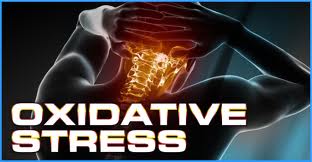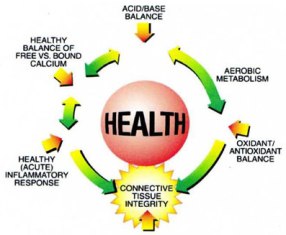
Oxygen is a dangerous friend. Overwhelming evidence indicates that oxidative stress can lead to cell and tissue injury. However, the same free radicals that are generated during oxidative stress are produced during normal metabolism and thus are involved in both human health and disease.
Free radicals are molecules with an odd number of electrons. The odd, or unpaired, electron is highly reactive as it seeks to pair with another free electron. Free radicals are generated during oxidative metabolism and energy production in the body.
Free radicals are involved in:
Enzyme-catalyzed reactions
Electron transport in mitochondria
Signal transduction and gene expression
Activation of nuclear transcription factors
Oxidative damage to molecules, cells, and tissues
Antimicrobial action of neutrophils and macrophages
Aging and disease
Normal metabolism is dependent on oxygen, a free radical. Through evolution, oxygen was chosen as the terminal electron acceptor for respiration. The two unpaired electrons of oxygen spin in the same direction; thus, oxygen is a biradical, but is not a very dangerous free radical. Other oxygenderived free radical species, such as superoxide or hydroxyl radicals, formed during metabolism or by ionizing radiation are stronger oxidants and are therefore more dangerous. In addition to research on the biological effects of these reactive oxygen species, research on reactive nitrogen species has been gathering momentum. NO, or nitrogen monoxide (nitric oxide), is a free radical generated by NO synthase (NOS). This enzyme modulates physiological responses such as vasodilation or signaling in the brain. However, during inflammation, synthesis of NOS (iNOS) is induced. This iNOS can result in the overproduction of NO, causing damage. More worrisome, however, is the fact that excess NO can react with superoxide to produce the very toxic product peroxynitrite. Oxidation of lipids, proteins, and DNA can result, thereby increasing the likelihood of tissue injury.
Both reactive oxygen and nitrogen species are involved in normal cell regulation in which oxidants and redox status are important in signal transduction. Oxidative stress is increasingly seen as a major upstream component in the signaling cascade involved in inflammatory responses, stimulating adhesion molecule and chemoattractant production. Hydrogen peroxide, which breaks down to produce hydroxyl radicals, can also activate NF-nB, a transcription factor involved in stimulating inflammatory responses. Excess production of these reactive species is toxic, exerting cytostatic effects, causing membrane damage, and activating pathways of cell death (apoptosis and/or necrosis). Virtually all diseases thus far examined involve free radicals. In most cases, free radicals are secondary to the disease process, but in some instances free radicals are causal. Thus, there is a delicate balance between oxidants and antioxidants in health and disease. Their proper balance is essential for ensuring healthy aging.
The term oxidative stress indicates that the antioxidant status of cells and tissues is altered by exposure to oxidants. The redox status is thus dependent on the degree to which a cell’s components are in the oxidized state. In general, the reducing environment inside cells helps to prevent oxidative damage. In this reducing environment, disulfide bonds (S—S) do not spontaneously form because sulfhydryl groups kept in the reduced state (SH) prevent protein misfolding or aggregation. This reducing environment is maintained by oxidative metabolism and by the action of antioxidant enzymes and substances, such as glutathione, thioredoxin, vitamins E and C, and enzymes such as superoxide dismutase (SOD), catalase, and the selenium-dependent glutathione and thioredoxin hydroperoxidases, which serve to remove reactive oxygen species.
Changes in the redox status and depletion of antioxidants occur during oxidative stress. The thiol redox status is a useful index of oxidative stress mainly because metabolism and NADPH-dependent enzymes maintain cell glutathione (GSH) almost completely in its reduced state. Oxidized glutathione (glutathione disulfide, GSSG) accumulates under conditions of oxidant exposure, and this changes the ratio of oxidized to reduced glutathione; an increased ratio indicates oxidative stress. Many tissues contain large amounts of glutathione, 2–4 mM in erythrocytes or neural tissues and up to 8 mM in hepatic tissues. Reactive oxygen and nitrogen species can directly react with glutathione to lower the levels of this substance, the cell’s primary preventative antioxidant.
Current hypotheses favor the idea that lowering oxidative stress can have a clinical benefit. Free radicals can be overproduced or the natural antioxidant system defenses weakened, first resulting in oxidative stress, and then leading to oxidative injury and disease. Examples of this process include heart disease and cancer. Oxidation of human low-density lipoproteins is considered the first step in the progression and eventual development of atherosclerosis, leading to cardiovascular disease. Oxidative DNA damage initiates carcinogenesis.
Compelling support for the involvement of free radicals in disease development comes from epidemiological studies showing that an enhanced antioxidant status is associated with reduced risk of several diseases. Vitamin E and prevention of cardiovascular disease is a notable example. Elevated antioxidant status is also associated with decreased incidence of cataracts and cancer, and some recent reports have suggested an inverse correlation between antioxidant status and occurrence of rheumatoid arthritis and diabetes mellitus. Indeed, the number of indications in which antioxidants may be useful in the prevention and/or the treatment of disease is increasing. Oxidative stress, rather than being the primary cause of disease, is more often a secondary complication in many disorders. Oxidative stress diseases include inflammatory bowel diseases, retinal ischemia, cardiovascular disease and restenosis, AIDS, ARDS, and neurodegenerative diseases such as stroke, Parkinson’s disease, and Alzheimer’s disease. Such indications may prove amenable to antioxidant treatment because there is a clear involvement of oxidative injury in these disorders. In this series of books, the importance of oxidative stress in diseases associated with organ systems of the body is highlighted by exploring the scientific evidence and the medical applications of this knowledge. The series also highlights the major natural antioxidant enzymes and antioxidant substances such as vitamins E, A, and C, flavonoids, polyphenols, carotenoids, lipoic acid, and other nutrients present in food and beverages.
notable example. Elevated antioxidant status is also associated with decreased incidence of cataracts and cancer, and some recent reports have suggested an inverse correlation between antioxidant status and occurrence of rheumatoid arthritis and diabetes mellitus. Indeed, the number of indications in which antioxidants may be useful in the prevention and/or the treatment of disease is increasing. Oxidative stress, rather than being the primary cause of disease, is more often a secondary complication in many disorders. Oxidative stress diseases include inflammatory bowel diseases, retinal ischemia, cardiovascular disease and restenosis, AIDS, ARDS, and neurodegenerative diseases such as stroke, Parkinson’s disease, and Alzheimer’s disease. Such indications may prove amenable to antioxidant treatment because there is a clear involvement of oxidative injury in these disorders. In this series of books, the importance of oxidative stress in diseases associated with organ systems of the body is highlighted by exploring the scientific evidence and the medical applications of this knowledge. The series also highlights the major natural antioxidant enzymes and antioxidant substances such as vitamins E, A, and C, flavonoids, polyphenols, carotenoids, lipoic acid, and other nutrients present in food and beverages.
Oxidative stress is an underlying factor in health and disease. More and more evidence indicates that a proper balance between oxidants and antioxidants is involved in maintaining health and longevity and that altering this balance in favor of oxidants may result in pathological responses causing functional disorders and disease. This series is intended for researchers in the basic biomedical sciences and clinicians. The potential for healthy aging and disease prevention necessitates gaining further knowledge about how oxidants and antioxidants affect biological systems.
![]()
Disclaimer: This website is for information purposes only. By providing the information contained herein we are not diagnosing, treating, curing, mitigating, or preventing any type of disease or medical condition. Before beginning any type of natural, integrative or conventional treatment regime, it is advisible to seek the advice of a licensed healthcare professional.


































